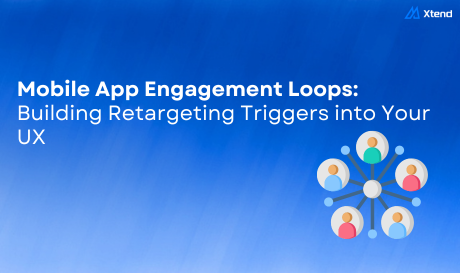In the fast-paced world of mobile apps, user engagement is king. With millions of apps vying for attention, keeping users engaged and returning is challenging. This is where mobile retargeting shines, offering a lifeline for businesses to reconnect with users through personalized and timely ad campaigns. At Xtend, we craft seamless retargeting solutions that re-engage users and drive conversions.
One of the most effective strategies for amplifying the impact of mobile retargeting is embedding engagement loops directly into your app’s user experience (UX). Let’s explore how you can build these retargeting triggers into your app to create a self-sustaining user engagement cycle.
What Are Engagement Loops?
Engagement loops are cyclical user journeys designed to bring users back into the app after their initial visit. These loops are crafted to hook users, offer value, and prompt them to return, creating a sustainable engagement cycle. Key components of an engagement loop include:
- Trigger: An event that prompts the user to take action.
- Action: The behavior you want the user to take (e.g., opening the app, making a purchase).
- Reward: A benefit the user receives for taking the action.
- Investment: A small user commitment that increases the likelihood of future actions (e.g., setting preferences, making a wishlist).
The Role of Retargeting Triggers in Engagement Loops
Retargeting triggers are the linchpin of an effective engagement loop. Integrating these triggers into your UX ensures users are re-engaged at critical points. Here’s how you can build them:
1. Behavioral Triggers
Behavioral triggers are based on specific user actions within the app. For example:
- Abandoned Carts: When users add items to their cart but don’t complete the purchase, a retargeting campaign can remind them with a personalized ad.
- Inactivity: If a user hasn’t opened the app in a while, a well-timed push notification or retargeted ad can reignite their interest.
2. Time-Based Triggers
Time-based triggers leverage the timing of user actions to deliver relevant ads. Examples include:
- Subscription Renewals: Remind users when their subscription is about to expire.
- Seasonal Offers: Engage users with time-sensitive promotions aligned with holidays or special events.
3. Contextual Triggers
Contextual triggers are based on the user’s context, such as location, time of day, or device type. For instance:
- Location-Based Offers: Send targeted ads for local deals when a user is near a physical store.
- Device-Specific Promotions: Tailor your campaigns based on the device the user is using to enhance their experience.
Closing the Loop: Continuous Optimization
The key to a successful engagement loop lies in continuous optimization. Monitor the performance of your retargeting campaigns and tweak them based on user feedback and behavioral data. At Xtend, we provide insights and analytics that help you refine your engagement loops and maximize user retention.
Building retargeting triggers into your UX isn’t just about returning users; it’s about creating a meaningful, ongoing relationship with them. By embedding these triggers into your app’s engagement loops, you ensure that users remain engaged, satisfied, and ultimately loyal to your brand.
At Xtend, we understand the intricacies of mobile user behavior and specialize in creating bespoke retargeting solutions that fit seamlessly into your app’s UX. Let’s work together to build engagement loops that bring users back and keep them returning for more.











